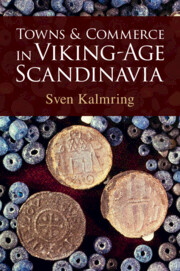Book contents
- Towns and Commerce in Viking-Age Scandinavia
- Additional material
- Towns and Commerce in Viking-Age Scandinavia
- Copyright page
- Epigraph
- Contents
- Plates
- Figures
- Maps
- Acknowledgements
- Abbreviations
- Maps
- 1 Introduction
- 2 The Viking-Age Town
- 3 The Viking World
- 4 Cult, Jurisdiction and Markets
- 5 Local Society and Viking-Age Towns
- 6 An Urbanisation Based on Harbours
- 7 Jurisdiction and Taxes
- 8 Free Trade within Narrow Boundaries
- 9 Special Economic Zones of Their Time
- 10 Development after the Inception Phase
- 11 Discussion: Hedeby’s Abandonment and the Foundation of Slesvig
- 12 Summary and Conclusions
- References
- Index
- Plate Section
7 - Jurisdiction and Taxes
Published online by Cambridge University Press: 04 January 2024
- Towns and Commerce in Viking-Age Scandinavia
- Additional material
- Towns and Commerce in Viking-Age Scandinavia
- Copyright page
- Epigraph
- Contents
- Plates
- Figures
- Maps
- Acknowledgements
- Abbreviations
- Maps
- 1 Introduction
- 2 The Viking-Age Town
- 3 The Viking World
- 4 Cult, Jurisdiction and Markets
- 5 Local Society and Viking-Age Towns
- 6 An Urbanisation Based on Harbours
- 7 Jurisdiction and Taxes
- 8 Free Trade within Narrow Boundaries
- 9 Special Economic Zones of Their Time
- 10 Development after the Inception Phase
- 11 Discussion: Hedeby’s Abandonment and the Foundation of Slesvig
- 12 Summary and Conclusions
- References
- Index
- Plate Section
Summary
By deliberately promoting certain trading sites, rulers extended their regalia rights in terms of the control and taxation of long-distance trade (Sawyer 1986: 73), a development that was initiated by providing a few selected places with a very distinct legal status that separated them from the context of ordinary society and triggered the transformation into early towns. Yet what this legal status entailed is hard to ascertain due to the dearth of contemporary sources, while in the case of later, high medieval law codes, one can only speculate about possible older origins. However, a closer look – both at written sources and archaeological evidence – reveals a whole range of clues that can help illuminate the existence and nature of this important judicial framework, which was an important part of the distinctiveness of these towns.
- Type
- Chapter
- Information
- Towns and Commerce in Viking-Age Scandinavia , pp. 84 - 104Publisher: Cambridge University PressPrint publication year: 2024

